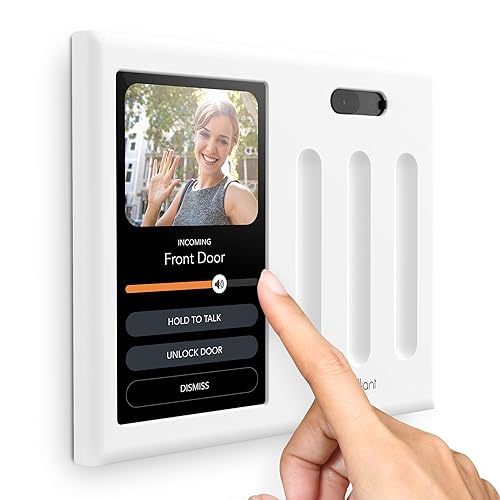
If you’re looking to buy Smart home device, you will notice that the product description and packaging itself displays which home systems it’s compatible with (like you’ll see along the bottom of the boxes in the right hand shot above). While some devices work across different platforms, you’ll have to go through the trouble of setting up the device from its own manufacturer app (the left image shows just one page of the dozens of smart home-related apps on my phone), make an account, and then pair it with each ecosystem of your choice in order to be recognized.
The process is cluttered and especially frustrating when you want to set up automated routines on devices across separate ecosystems. This fragmentation carries down to the way individual devices talk to each other. While your lights may connect to a mesh hub using Zigbee or Z-Wave, a smart plug may rely on WiFi which eats into your bandwidth and slows down network speeds for other devices. Although it’s less popular, some gadgets even function locally over a Bluetooth connection.
Expand your smart home
Lighting
Smart lights let you control your connected lights through your phone or by voice when paired with Alexa. You can create timers and routines to automate your entire smart home lighting setup.
Cameras
Smart cameras let you monitor activity inside and around your home. After connecting your cameras to Alexa, you can view footage on compatible Echo devices. Relax and be confident that you can keep an eye on what’s happening with the Amazon Alexa app, no matter where you are.
Televisions
Smart TVs let you use your voice to open streaming apps, change the channel, adjust the volume, and more when paired with an Alexa enabled device. When you’re done watching, just say, “Alexa”, turn off the TV.”
Thermostats
Heating and cooling costs can really add up. Smart thermostats can help you save energy by adjusting your home’s temperature when you’re away.
Showing 1–48 of 175 results
-
Sale!

2 Pack Home Security Door Lock Withstand 800 lbs for Inward Swinging Door,Door Reinforcement Lock with 8 Screws to Prevent Unauthorized Entry,Extra Security Door Locks for Home Security and Privacy
Original price was: $25.99.$18.99Current price is: $18.99. Learn More -

6 USB(2 USB C) Surge Protector Power Strip- 5Ft Travel Power Strip with 4.8A USB Charging Station and 4 Outlets, 13A Ultra Thin Flat Plug Braided Extension Cord with Wall Mount for Travel Office Dorm
$23.99 Learn More -
Sale!

Acuva- ArrowMax 2.0 UV-LED Water Purifier, Under Sink Water Filter System with Smart Faucet, Universal Power Supply, Brushed Nickel Faucet
Original price was: $539.10.$359.40Current price is: $359.40. Learn More -

All-New 2023 WiFi Extender 1.2Gb/s Signal Booster – Dual Band 5GHz & 2.4GHz, New Generation up to 4X Faster, Longest Range Than Ever Super Antennas, Signal Amplifier w/Ethernet Port, Alexa Compatible
$39.99 Learn More -
Sale!

All-new Amazon Fire TV Stick 4K Max streaming device, supports Wi-Fi 6E, Ambient Experience, free & live TV without cable or satellite
Original price was: $59.99.$39.99Current price is: $39.99. Learn More -
Sale!

All-new Amazon Fire TV Stick 4K streaming device, includes support for Wi-Fi 6, Dolby Vision/Atmos, free & live TV
Original price was: $49.99.$24.99Current price is: $24.99. Learn More -
Sale!

All-new Echo Show 5 (3rd Gen, 2023 release) | Smart display with 2x the bass and clearer sound | Charcoal
Original price was: $89.99.$39.99Current price is: $39.99. Learn More -
Sale!

All-new Echo Show 8 (3rd Gen, 2023 release) | With Spatial Audio, Smart Home Hub, and Alexa | Charcoal
Original price was: $149.99.$104.99Current price is: $104.99. Learn More -

Amazon Basics Smart A19 LED Light Bulb, red, green, blue, white. color changing, 2.4 GHz Wi-Fi, 7.5 W 60W Equivalent 800LM, Works with Alexa Only, 4-Pack, Certified for Humans
$41.99 Learn More -

Amazon Basics Smart In-Wall Outlet with 2 Individually Controlled Outlets, Tamper Resistant, 2.4 GHz Wi-Fi, Works with Alexa Only, 4.57 x 2.80 x 1.85 inches, White
$18.80 Learn More -
Sale!

Amazon Echo Dot (5th Gen) with clock | Compact smart speaker with Alexa and enhanced LED display for at-a-glance clock, timers, weather, and more | Glacier White
Original price was: $59.99.$39.99Current price is: $39.99. Learn More -
Sale!

Amazon Fire TV Stick with Alexa Voice Remote (includes TV controls), free & live TV without cable or satellite, HD streaming device
Original price was: $39.99.$19.99Current price is: $19.99. Learn More -

Amazon Smart Thermostat – Save money and energy – Works with Alexa and Ring – C-wire required
$79.99 Learn More -

Aoycocr Alexa Smart Plugs – Mini Bluetooth WIFI Smart Socket Switch Works With Alexa Echo Google Home, Remote Control Smart Outlet with Timer Function, No Hub Required, ETL/FCC Listed 4 Pack
$25.99 Learn More -

Arpha Fingerprint Door Lock with APP Control, 5-in-1 Biometric Smart Lock, Bluetooth Keyless Entry Door Lock, Electronic Front Door Lock Easy Installation, Anti-Peeping Password, Zinc Alloy Black
$75.99 Learn More -

Arpha Fingerprint Door Lock with App Control, Deadbolt Smart Lock for Front Door, Keyless Entry Door Lock with Anti-Peeping Password, Touchscreen Digital Lock Once Time Code Easy to Install Zinc Alloy
$77.99 Learn More -

Astronaut Projector, Galaxy Projector for Bedroom, Star Projector Galaxy Night Light with Remote & Bluetooth Speaker, Kids Adults Room Decor Aesthetic, Gifts for Christmas, Birthdays
$39.99 Learn More -
Sale!

Beysen Smart Plug, Smart Outlet Bluetooth Mesh, Smiple Set Up, Alexa App Remote Control and Alexa Voice Control, ETL & FCC Certified, 4 Pack 666 (4 Pack)
Original price was: $29.99.$24.99Current price is: $24.99. Learn More -
Sale!

Bidet Attachment – SAMODRA Non-electric Cold Water Bidet Toilet Seat Attachment with Pressure Controls,Retractable Self-cleaning Dual Nozzles for Frontal & Rear Wash – Black
Original price was: $49.96.$34.99Current price is: $34.99. Learn More -
Sale!

BLACK+DECKER Works with Alexa Smart Under Cabinet Lighting Kit, Adjustable LEDs, (6) 9″ Bars, White,A Certified for Humans Device
Original price was: $179.99.$139.58Current price is: $139.58. Learn More -

Blink Video Doorbell | Two-way audio, HD video, motion and chime app alerts, and Alexa enabled — wired or wire-free (White)
$59.99 Learn More -
Sale!

Blink Wired Floodlight Camera – Smart security camera, 2600 lumens, HD live view, enhanced motion detection, built-in siren, Works with Alexa – 1 camera (Black)
Original price was: $99.99.$49.99Current price is: $49.99. Learn More -

BN-LINK WiFi Heavy Duty Smart Plug Outlet, No Hub Required with Timer Function, White, Compatible with Alexa and Google Assistant, 2.4 Ghz Network Only (4 Pack)
$24.99 Learn More -
Sale!

Brilliant Smart Home Control (3-Switch Panel) — Alexa Built-In & Compatible with Ring, Sonos, Hue, Google Nest, Wemo, SmartThings, Apple HomeKit — In-Wall Touchscreen Control for Lights, Music, & More
Original price was: $499.00.$449.10Current price is: $449.10. Learn More -
Sale!

Certified Refurbished Amazon Smart Thermostat – ENERGY STAR certified, DIY install, Works with Alexa – C-wire required
Original price was: $69.99.$34.99Current price is: $34.99. Learn More -
Sale!

CHAMBERLAIN Smart Garage Control – Wireless Garage Hub and Sensor with Wifi & Bluetooth – Smartphone Controlled, myQ-G0401-ES, White
Original price was: $29.98.$24.98Current price is: $24.98. Learn More -
Sale!

Charging Station for Multiple Devices 40W Upoy, Wall Charger Block 5 USB Ports(Shared 6A), USB Charging Hub Smart IC, Charger Tower with Type-C 3A for iPhone iPad Tablets Smartphones, Home Office Use
Original price was: $26.99.$14.99Current price is: $14.99. Learn More -
Sale!

Clear Rear Bidet Attachment for Toilet – Get a Splash of Freshness w/Our Self-Cleaning Bidet – Dual Nozzle Toilet Bidet Attachment w/Adjustable Water Pressure – Toilet Accessories for Hygiene, FSA HSA
Original price was: $59.99.$44.95Current price is: $44.95. Learn More -

DAYBETTER Smart Light Bulbs, Alexa Light Bulb, WiFi Light Bulbs, RGBCW Color Changing Light Bulb A19 9W 800LM, Smart Bulbs that Work with Alexa & Google Assistant, 2.4Ghz only, No Hub Required,10 Pack
$59.99 Learn More -

DAYBETTER Smart Light Bulbs, RGBCW Wi-Fi Color Changing Led Bulbs Compatible with Alexa & Google Home Assistant, A19 E26 9W 800LM Multicolor Bulb, No Hub Required, 6 Pack
$36.99 Learn More -
Sale!

Echo (4th Gen) | With premium sound, smart home hub, and Alexa | Charcoal
Original price was: $99.99.$59.99Current price is: $59.99. Learn More -
Sale!

Echo Auto (2nd Gen, 2022 release) | Add Alexa to your car
Original price was: $54.99.$34.99Current price is: $34.99. Learn More -
Sale!

Echo Dot (5th Gen, 2022 release) | With bigger vibrant sound, helpful routines and Alexa | Deep Sea Blue
Original price was: $49.99.$22.99Current price is: $22.99. Learn More -
Sale!

Echo Dot (5th Gen, 2022 release) Kids | Designed for kids, with parental controls | Owl
Original price was: $59.99.$27.99Current price is: $27.99. Learn More -

Echo Glow – Multicolor smart lamp, a Certified for Humans Device – Requires compatible Alexa device
$29.99 Learn More -
Sale!

Echo Show 10 (3rd Gen) | HD smart display with motion and Alexa | Charcoal
Original price was: $249.99.$159.99Current price is: $159.99. Learn More -
Sale!

Echo Show 8 (2nd Gen, 2021 release) | HD smart display with Alexa and 13 MP camera | Charcoal
Original price was: $129.99.$54.99Current price is: $54.99. Learn More -
Sale!

Echo Studio | Our best-sounding smart speaker ever – With Dolby Atmos, spatial audio processing technology, and Alexa | Charcoal
Original price was: $199.99.$154.99Current price is: $154.99. Learn More -
Sale!

ecobee Smart Sensor 2 Pack – Comfort, Security, Energy Savings – Smart Home – Compatible with ecobee Smart Thermostats for Home
Original price was: $99.99.$78.99Current price is: $78.99. Learn More -
Sale!

ecobee3 Lite Smart Thermostat – Programmable Wifi Thermostat – Works with Siri, Alexa, Google Assistant – Energy Star Certified – DIY Install, Black
Original price was: $149.99.$126.99Current price is: $126.99. Learn More -

eufy Security Indoor Cam S350, Dual Cameras, 4K UHD Resolution Security Camera with 8× Zoom and 360° PTZ, Human/Pet AI, Ideal for Baby Monitor/Pet Camera/Home Security, Dual-Band Wi-Fi 6, Plug in
$129.99 Learn More -

Exioty Mini Smart Plug, Compatible with Alexa Only, Simple to Set Up with One Voice Command, Voice Control, Remote Control, Timer & Schedulete & Group Controller, Alexa Echo Required (4 Pack)
$19.98 Learn More -

Exioty Smart Plug EX-1, Simple to Set Up with One Voice Command, Works with Alexa, Remote Control, Timer & Schedulete & Group Controller, ETL & FCC Certified, Alexa Echo Required(4 Pack)
$19.97 Learn More -
Sale!

EZVALO Smart Desk Lamp with APP Control,Eye-Caring Auto-Dimming Led Desk Lamp,3 Color Temperature, Works with Alexa&Google Assistant, Study Lamp with Clock, Desk Lamps for Home Office Reading,Studying
Original price was: $84.99.$68.99Current price is: $68.99. Learn More -

Feit Electric Smart Plug, WiFi Plug Compatible with Alexa and Google Home, Indoor Plug, No Hub Required, 2.4Ghz Network, Remote Control from Anywhere, 15 AMP, Smart Outlet Plug, White (Pack of 2)
$29.98 Learn More -

Fingerprint Door Lock, GHome Smart Door Knob with App Smart Lock for Bedroom Door, Keyless Entry, Type-C Port Emergency Charging, Biometric Lock Great for Room, Garage, Office, Apartment (Matt Black)
$59.99 Learn More -

Fingerprint Front Door Lock Set with Deadbolt, Guarder Electronic Deadbolt Lock for Door,Keyless Entry Door Lock with Code/Fingerprint/Key, IP65 Alloy Material Digital Door Locks for Front Door
$89.98 Learn More -
Sale!

FLITI The Largest Coverage Area Galaxy Lights Projector 2.0, Star Projector, with Changing Nebula and Galaxy Shapes Night Light
Original price was: $49.99.$39.99Current price is: $39.99. Learn More
















































